Making Sense of Complexity: Using SenseMaker as a Research Tool
Abstract
1. Introduction
2. The Cynefin Framework and SenseMaker Tool
3. Applications
4. Guidelines for Using SenseMaker as a Research Approach
4.1. Step 1: Initiation through to Instrument Deployment
4.1.1. Conceptual Design
4.1.2. Detailed Design: Signification Framework
4.1.3. Instrument Usability Tests and Online Deployment
4.2. Step 2: Story Collection: Narrative Collection Strategy and Data Capture
4.3. Step 3: Exploratory Data Analysis and Sensemaking
4.3.1. Exploratory Analysis
4.3.2. Collective Sensemaking
4.4. Step 4: Response to Affect Change in the System
5. SenseMaker Limitations and Suggestions for Future Development
5.1. Research Method
5.2. Socio-Technical Considerations
6. Conclusions
Author Contributions
Funding
Acknowledgments
Conflicts of Interest
References
- Weick, K.E. Sensemaking in Organizations; Sage Publications: Thousand Oaks, CA, USA; London, UK; New Delhi, India, 1995; ISBN 0803971761. [Google Scholar]
- Kudesia, R.S. Organizational Sensemaking; Oxford University Press: New York, NY, USA, 2017. [Google Scholar]
- Daft, R.L.; Weick, K.E. Toward a Model of Organizations as Interpretation Systems. Acad. Manag. Rev. 1984, 9, 284–295. [Google Scholar] [CrossRef]
- Weick, K.E. Enacted Sensemaking in Crisis Situations. J. Manag. Stud. 1988, 25, 305–317. [Google Scholar] [CrossRef]
- Dervin, B. Sense-Making Methodology Reader: Selected Writings of Brenda Dervin; Dervin, B., Foreman-Wernet, L., Launterback, E., Eds.; Hampton Press: Cresskill, NJ, USA, 2003. [Google Scholar]
- Weick, K.E.; Sutcliffe, K.M.; Obstfeld, D. Organizing and the process of sensemaking. Organ. Sci. 2005, 16, 409–421. [Google Scholar] [CrossRef]
- Colville, I.; Pye, A.; Carter, M. Organizing to counter terrorism: Sensemaking amidst dynamic complexity. Hum. Relat. 2013, 66, 1201–1223. [Google Scholar] [CrossRef]
- Weick, K.E. The Collapse of Sensemaking in Organizations: The Mann Gulch Disaster. Admin. Sci. Q. 1993, 38, 628–652. [Google Scholar] [CrossRef]
- Weber, K.; Glynn, M.A. Making sense with institutions: Context, thought and action in Karl Weick’s theory. Organ. Stud. 2006, 27, 1639–1660. [Google Scholar] [CrossRef]
- Fisher, W.R. Homo Narrans: The narrative paradigm: In the beginning. J. Commun. 1985, 35, 74–89. [Google Scholar] [CrossRef]
- Dervin, B. Sense-making theory and practice: An overview of user interests in knowledge seeking and use. J. Knowl. Manag. 1998, 2, 36–46. [Google Scholar] [CrossRef]
- Niles, J.D. Homo Narrans: The Poetics and Anthropology of Oral Literature; University of Pennsylvania Press: Philadelphia, PA, USA, 2010; ISBN 0812202953, 9780812202953. [Google Scholar]
- Snowden, D.J. Naturalizing Sensemaking. In Informed by Knowledge: Expert Performance in Complex Situations; Mosier, K.L., Fischer, U.M., Eds.; Taylor & Francis: New York, NY, USA; London, UK, 2011; pp. 223–234. ISBN 978-1-84872-911-7. [Google Scholar]
- Kurtz, C.F.; Snowden, D.J. The new dynamics of strategy: Sense-making in a complex and complicated world. IBM Syst. J. 2003, 32, 462–483. [Google Scholar] [CrossRef]
- Caracciolo, M. Narrative, meaning, interpretation: An enactivist approach. Phenomenol. Cogn. Sci. 2012, 11, 367–384. [Google Scholar] [CrossRef]
- Casella, D.; Magara, P.; Kumasi, T.C.; Guijt, I.; Van Soest, A. The Triple-S Project Sense Maker Experience: A Method Tested and Rejected (Triple-S Working Paper 9); IRC International Water and Sanitation Centre: The Hague, The Netherlands, 2014. [Google Scholar]
- Finidori, H.; Tuddenham, P. Pattern Literacy in Support of Systems Literacy—An approach from a Pattern Language perspective. In Proceedings of the HILLSIDE Conference on Pattern Languages of Programs, Vancouver, BC, Canada, 22–25 October 2017; HILLSIDE: Vancouver, BC, Canada, 2017; pp. 1–32. [Google Scholar]
- Waddock, S. Reflections: Intellectual Shamans, Sensemaking, and Memes in Large System Change. J. Chang. Manag. 2015, 15, 259–273. [Google Scholar] [CrossRef]
- Haynes, P. Social Synthesis: Finding Dynamic Patterns in Complex Social Systems; Routledge: New York, NY, USA, 2018; ISBN 978-1-325-45853-3. [Google Scholar]
- Weaver, W. Science and Complexity. Am. Sci. 1948, 36, 536–544. [Google Scholar] [PubMed]
- La Porte, T.R. Organized Social Complexity: Challenge to Politics and Policy; La Porte, T.R., Ed.; Princeton University Press: Princeton, NJ, USA, 1975. [Google Scholar]
- Morgan, P. The Idea and Practice of Systems Thinking and Their Relevance for Capacity Development; European Centre for Development Policy Management: Maastricht, The Netherlands, 2005. [Google Scholar]
- Castelliani, B. Fast Growing Complexity Sciences and their Controversial Tangle with Social Inquiry. Available online: https://www.theoryculturesociety.org/brian-castellani-on-the-complexity-sciences/ (accessed on 6 March 2018).
- Byrne, D.S.; Callaghan, G. Complexity Theory and The Social Sciences: The State of The Art; Routledge: Abingdon, UK; New York, NY, USA, 2013; ISBN 9780415693684. [Google Scholar]
- Kurtz, C.F.; Snowden, D.J. Bramble bushes in a thicket narrative and the intangibles of learning networks. In Strategic Networks: Learning to Compete (Strategic Management Society); Gibbert, M., Durand, T., Eds.; Blackwell Publishing: Malden, MA, USA, 2007; pp. 121–150. ISBN 978-1405135856. [Google Scholar]
- Uhl-Bien, M.; Marion, R. Complexity leadership in bureaucratic forms of organizing: A meso model. Leadersh. Q. 2009, 631–650. [Google Scholar] [CrossRef]
- Audouin, M.; Preiser, R.; Nienaber, S.; Downsborough, L.; Lanz, J.; Mavengahama, S. Exploring the implications of critical complexity for the study of social-ecological systems. Ecol. Soc. 2013, 18, 12. [Google Scholar] [CrossRef]
- Lemaster, C. Leading Change in Complex Systems: A Paradigm Shift; Antioch University: Culver City, CA, USA, 2017. [Google Scholar]
- Kolko, J. Abductive Thinking and Sensemaking: The Drivers of Design Synthesis. MIT’s Des. Issues 2010, 26, 15–28. [Google Scholar] [CrossRef]
- Klein, G. Seeing What Others Don’t: The Remarkable Ways We Gain Insights; Nicholas Brealey Publishing: London, UK; Boston, MA, USA, 2013; ISBN 9781857886191. [Google Scholar]
- Weick, K.E. Making sense of the Organization; Blackwell: Oxford, UK, 2001. [Google Scholar]
- Checkland, P. Soft Systems Methodology: A Thirty Year Retrospective. Syst. Res. Behav. Sci. 2000, 17, S11–S58. [Google Scholar] [CrossRef]
- Patriotta, G. Sensemaking on the Shop Floor: Narratives of Knowledge in Organizations. J. Manag. Stud. 2003, 40, 349–375. [Google Scholar] [CrossRef]
- Thurlow, A.; Helms Mills, J. Change, talk and sensemaking. J. Organ. Chang. Manag. 2009, 22, 459–479. [Google Scholar] [CrossRef]
- Kurtz, C.F. Working with Stories in Your Community or Organization, Participatory Narrative Inquiry, 3rd ed.; Kurtz-Fernhout Publishing: New York, NY, USA, 2014; ISBN 978-0991369409. [Google Scholar]
- VanPatter, G.; Pastor, E. Innovation Methods Mapping: De-Mystifying 80+ Years of Innovation Process Design; Humantific Publishing: New York, NY, USA, 2016. [Google Scholar]
- Cognitive Edge Cognitive Edge Landing Page. Available online: http://cognitive-edge.com/ (accessed on 4 February 2018).
- Snowden, D.J. Appendix 2: Narrative research, The pattern basis of human intelligence. Nat. Decis. Mak. Conf. 2008, 2010, 21. [Google Scholar]
- Elford, W.D. Using narrative in ergonomics research and practice. In Proceedings of the HFESA 47th Annual Conference, Crows Nest, Australia, 7–9 November 2011; pp. 1–5. [Google Scholar]
- Ray, K.W.; Goppelt, J. Understanding the effects of leadership development on the creation of organizational culture change: A research approach. Int. J. Train. Dev. 2011, 15, 58–75. [Google Scholar] [CrossRef]
- Dunstan, K. Exploring Anticipatory Emotions and Their Role in Self-Perceived B2B Salesperson Effectiveness. Ph.D. Thesis, Curtin University of Technology, Perth, Australia, 2016. [Google Scholar]
- Mark, A.; Snowden, D.J. Cynefin: A tool for situating the problem in a sense-making framework. In Applied Systems Thinking for Health Systems Research, A Methodological Handbook; de Savigny, D., Blanchet, K., Adam, T., Eds.; McGraw-Hill Education, Open University Press: London, UK, 2017; pp. 76–96. ISBN 978-0-335-26132-1. [Google Scholar]
- Polk, R.B. A Multimodal Study on How Embodiment Relates to Perception of Complexity. Ph.D. Thesis, Fielding Graduate University, Santa Barbara, CA, USA, 2017. [Google Scholar]
- Bartels, S.A.; Michael, S.; Roupetz, S.; Garbern, S.; Kilzar, L.; Bergquist, H.; Bakhache, N.; Davison, C.; Bunting, A. Making sense of child, early and forced marriage among Syrian refugee girls: A mixed methods study in Lebanon. BMJ Glob. Heal. 2018, 3, e000509. [Google Scholar] [CrossRef]
- RAHS Thinking about the Future, Strategic Anticipation and RAHS. In Proceedings of the 2nd International Risk Assessment and Horizon Scanning Symposium; Tan Hong Ngoh, E., Hoo Tiang, B., Eds.; National Security Coordination Secretariat & S Rajaratnam School of International Studies: Singapore, 2008. [Google Scholar]
- Snowden, D.J.; Boone, M.E. A leader’s framework for decision making. Harv. Bus. Rev. 2007. Available online: https://hbr.org/2007/11/a-leaders-framework-for-decision-making (accessed on 29 June 2016).
- Brougham, G. The Cynefin Mini-Book, an Introduction to Complexity and the Cynefin Framework; Ciobotaru, A., Ed.; Utah State University Press: Logan, UT, USA, 2015; ISBN 9780874216561. [Google Scholar]
- Snowden, D.J. Complex Acts of Knowing: Paradox and Descriptive Self-Awareness. J. Knowl. Manag. 2002, 6, 100–111. [Google Scholar] [CrossRef]
- Snowden, D.J. Cynefin, A Sense of Time and Place: An Ecological Approach to Sense Making and Learning in Formal and Informal Communities. In Proceedings of the Knowledge Management Aston Conference; KMAC, Birmingham, UK, 17–18 July 2000. [Google Scholar]
- Juarrero, A. Complex Dynamical Systems Theory. Available online: http://cognitive-edge.com/articles/complex-dynamical-systems-theory/ (accessed on 29 June 2016).
- Juarrero. The Cynefin Centre: Life after IBM. KM World. 2005, 14. Available online: http://www.kmworld.com/Articles/News/News-Analysis/The-Cynefin-Centre-Life-after-IBM-14542.aspx (accessed on 29 June 2016).
- Ali, I. Methodological Approaches for Researching Complex Organizational Phenomena. Inf. Sci. Int. J. Emerg. Transdiscipl. 2014, 17, 59–73. [Google Scholar]
- Castelliani, B. Map of Complexity Sciences. Available online: http://www.art-sciencefactory.com/complexity-map_feb09.html (accessed on 11 January 2018).
- Cognitive Edge SenseMaker® SCANs. Available online: http://cognitive-edge.com/sensemaker/#sensemaker-scans (accessed on 1 July 2017).
- Deprez, S.; Huyghe, C.; Van Gool Maldonado, C. Using Sensemaker to Measure, Learn and Communicate about Smallholder Farmer Inclusion, Thematic Learning Programme on Planning, Monitoring and Evaluation of Complex Processes of Social Change; VECO: Vredeseilanden, Belgium, 2012. [Google Scholar]
- Mager, F.; Smith, B.; Guijt, I. How Decent is Decent Work? Using Sense Maker to Understand Workers’ Experiences; Oxfam: Oxford, UK, 2018. [Google Scholar]
- Creswell, J. Philosophical, Paradigm, and Interpretive Frameworks. In Qualitative Inquiry and Research Design, Choosing among Five Approaches; SAGE Publications: Thousand Oaks, CA, USA; London, UK; New Delhi, India, 2007; pp. 15–34. ISBN 9781412916066. [Google Scholar]
- Caine, V.; Estefan, A.; Clandinin, D.J. A Return to Methodological Commitment: Reflections on Narrative Inquiry. Scand. J. Educ. Res. 2013, 57, 574–586. [Google Scholar] [CrossRef]
- Guijt, I. Voices in the Room: Stories, Statistics & Systemic Change. Available online: https://www.youtube.com/watch?v=gOQGMlZSARc (accessed on 29 May 2017).
- Milne, K.M.G. Can sense-making tools inform adaptation policy? A practitioner’s perspective. Ecol. Soc. 2015, 20, 66. [Google Scholar] [CrossRef]
- Fierro, R.S.; Tirfe, M.; Demmelash, Y.; Zewdu, Y. Girlhub: Pilot Study Report, Collecting Girls’ Stories in Ethiopia; Girlhub Ethiopia, Girl Effect: Addis Ababa, Ethiopia, 2012. [Google Scholar]
- Cognitive Edge SenseMaker® Access and Use Agreement. Available online: http://cognitive-edge.com/sensemaker/sensemaker-service-terms/ (accessed on 5 June 2018).
- Jenal, M. A New Framework for Assessing Systemic Change in Katalyst: The Pilot Study in Local Agri-Business Network; Swiss Foundation for Technical Cooperation: Zurich, Switzerland, 2016. [Google Scholar]
- Guijt, I. Innovation in evaluation, using SenseMaker to assess the inclusion of smallholder farmers in modern markets. In Monitoring and Evaluation in Health and Social Development: Interpretive and Ethnographic Perspectives; Bell, S., Aggleton, P., Eds.; Routledge, Taylor & Francis: London, UK; New York, NY, USA, 2016; p. 274. ISBN 978-1-138-84415-5. [Google Scholar]
- Van Hemelrijck, A. Improved Learning Initiative for the Design of a Participatory Impact Assessment & Learning Approach (PIALA), Methodological Reflections Following the Second PIALA Pilot in Ghana; International Fund for Agricultural Development (IFAD): Rome, Italy, 2016. [Google Scholar]
- Jenal, M. Peer-to-Peer Workshop Reveals Growing Interest in SenseMaker®. Available online: https://beamexchange.org/community/blogs/2015/10/30/sensemaker1015/ (accessed on 20 November 2017).
- Metheou, A.; Bhagani, H. IFRC Southern Africa Grassroots Consultations: 1000 Stories from Southern Africa Preliminary Report. In Proceedings of the World Humanitarian Summit Regional Consultation for Eastern and Southern Africa, Pretoria, South Africa, 27–29 October 2014; International Federation of Red Cross and Red Crescent Societies: Gaborone, Botswana, 2014. [Google Scholar]
- Jenal, M. Measuring Social Change: Human Rights-Based Approaches, change in farmers perceptions and attitudes in Bangladesh. In Proceedings of the Cognitive Edge Network Webinar: SenseMaker and Social Change Dynamics in Society, 20 December 2017; Webster, L., Ed.; Cognitive Edge: Saratoga Springs: New York, NY, USA, 2017. Available online: https://cognitive-edge.wistia.com/medias/nc1oib4v01 (accessed on 5 January 2018).
- Deprez, S.; Van den Steen, T.; Van Ongeval, K. Voices that Count, The Inclusive Business Scan, Powered by Sensemaker®; Rikolto: Leuven, Belgium, 2016. [Google Scholar]
- Huyghe, C. Voices that Count, Learning about Inclusive Business using Sensemaker; Rikolto (formerly VECO): Leuven, Belgium, 2015. [Google Scholar]
- Dijkstra, A. Understanding Resilience in Flight Operations “Find the story behind flight safety reports and learn from successes”. In Proceedings of the Resilience Engineering Symposium 2013, Soesterberg, The Netherlands, 8–10 June 2011; Herrera, I., Schraagen, J.M., Van der Vorm, J., Woods, D., Eds.; Resilience Engineering Association: Soesterberg, The Netherlands, 2013. [Google Scholar]
- Lynam, T.; Walker, I. Making sense of climate change: Orientations to adaptation. Ecol. Soc. 2016, 21. [Google Scholar] [CrossRef]
- Lynam, T.; Fletcher, C. Sensemaking: A complexity perspective. Ecol. Soc. 2015, 20. [Google Scholar] [CrossRef]
- Sardone, G.; Wong, G.S. Making Sense of Safety: A Complexity-based Approach to Safety Interventions. In Proceedings of the Association of Canadian Ergonomists 41st Annual Conference, Albuquerque, NM, USA, 4–7 October 2010; Association of Canadian Ergonomists: Kelowna, BC, Canada, 2010. [Google Scholar]
- van Ophoven, A.; Pauwels, P.; Stienstra, J. Enlightened gardens, innovation beyond the obvious. In Proceedings of the Esomar World Research Congress, Amsterdam, The Netherlands, 18–21 September 2011. [Google Scholar]
- Bakhache, N.; Michael, S.; Roupetz, S.; Garbern, S.; Bergquist, H.; Davison, C.; Bartels, S. Implementation of a SenseMaker® research project among Syrian refugees in Lebanon. Glob. Health Action 2017, 10, 1362792. [Google Scholar] [CrossRef]
- Burman, C.J. Re-contextualizing medical pluralism in South Africa: A research schema for indigenous decision making. Syst. Pract. Action Res. 2018, 24. [Google Scholar] [CrossRef]
- Moriarty, D.; Steinhardt, G.; Frank, M.; Dijkstra, A. Engineering resilience. AeroSpace R. Aeronaut. Soc. 2016, 43, 34–37. [Google Scholar]
- Mattila, N. SenseMaker is a Tool for Decision-Making in a New Kind of World. Available online: https://www.sitra.fi/en/articles/sensemaker-tool-decision-making-new-kind-world/ (accessed on 10 August 2018).
- Gottret, M.V. Understanding and Assessing Resilience: A Sensemaker-Based Methodology; Caritas Relief Services: Baltimore, MD, USA, 2017. [Google Scholar]
- Will, M.S. Resilience, Capabilities and Complexity: The Face of Bouncing-Back. Available online: https://flourishinganddisadvantage.com/2015/10/13/resilience-capabilities-and-complexity-the-face-of-bouncing-back/ (accessed on 25 June 2018).
- Will, M.S. Making Sense of Complexity: Review of SenseMaker for Development. Available online: https://flourishinganddisadvantage.com/2016/12/08/making-sense-of-complexity-review-of-sensemaker-for-development/ (accessed on 11 November 2017).
- Likens, S.; Ho, J.; Yao, Y.; Lu, G. Big Decisions 2.0: How Corporate Decision Making is Changing in China, Shanghai, China, 2016.
- Stienstra, J.; van der Loser Noort, W. Hhero or human being, are you ready for emergent truth? In Proceedings of the Esomar World Research Congress, Montreal, QC, Canada, 22–25 September 2008; ESOMAR: Amsterdam, The Netherlands, 2008. [Google Scholar]
- Koh, G.; Koh, V.; Kiat, T.E. Governance in 2022, Views from the IPS Prism Immersive Arts Experience. In Proceedings of the Engaging Minds, Exchanging Ideas, 28 January 2013; Institute of Policy Studies, LKY School of Public Policy, National University of Singapore: Singapore, 2013. [Google Scholar]
- Jaye, M.; Driscoll, P.J.; Choe, D.; Diaz, V.; Keller, A. Soldier narrative analysis as part of a rapid fielding program. In Proceedings of the 5th International Conference on Applied Human Factors and Ergonomics 20 Volume Set, Kraków, Poland, 19–23 July 2014; pp. 3–10. [Google Scholar]
- Cuganesan, S.; Dumay, J.C. Reflecting on the production of intellectual capital visualisations. Account. Audit. Account. J. 2009, 22, 1161–1186. [Google Scholar] [CrossRef]
- Burman, C.J.; Aphane, M.; Delobelle, P. Weak signal detection: A discrete window of opportunity for achieving ‘vision 90:90:90’? Sahara J. 2016, 13, 16–34. [Google Scholar] [CrossRef] [PubMed]
- SITRA SenseMaker Tool Experiments. Available online: https://www.sitra.fi/en/projects/sensemaker-tool-experiments/ (accessed on 12 August 2018).
- Cognitive Edge Safe-to-Fail Probes. Available online: http://cognitive-edge.com/methods/safe-to-fail-probes/ (accessed on 28 November 2015).
- Podsakoff, P.M.; MacKenzie, S.B.; Podsakoff, N.P. Recommendations for Creating Better Concept Definitions in the Organizational, Behavioral, and Social Sciences. Organ. Res. Methods 2016, 19, 159–203. [Google Scholar] [CrossRef]
- James, L.R.; Jones, A.P. Organizational climate: A review of theory and research. Psychol. Bull. 1974, 81, 1096–1112. [Google Scholar] [CrossRef]
- Kahneman, D. Thinking Fast and Slow; Farrar, Straus and Giroux: New York, NY, USA, 2011. [Google Scholar]
- Elford, W.D. Emerging Issues in Ergonomics: A Methodological Framework for Foresight and Sensemaking. Ph.D. Thesis, University of Canberra, Canberra, Australia, 2011. [Google Scholar]
- Cognitive Edge Why cultureSCAN. Available online: http://kafka.sensemaker-suite.com/Collector/collector.gsp?projectID=cultureSCAN&language=en#Collector (accessed on 20 September 2017).
- Wicks, A.C.; Berman, S.L.; Jones, T.M. The Structure of Optimal Trust: Moral and Strategic Implications. Available online: https://doi.org/10.5465/amr.1999.1580443 (accessed on 5 August 2018).
- Snowden, D.J. Complex Systems Strategy: Thinking Aloud. Available online: http://cognitive-edge.com/blog/complex-systems-strategy-thinking-aloud/ (accessed on 17 June 2018).
- DeLong, S. Statistics in the Triad. Available online: http://qedinsight.com/tag/statistics/ (accessed on 2 July 2017).
- Smith, A.; Yetim, F. Global human–computer systems: Cultural determinants of usability. Interact. Comput. 2004, 16, 1–5. [Google Scholar] [CrossRef]
- Chilisa, B. Educational research within postcolonial Africa: A critique of HIV/AIDS research in Botswana. Int. J. Qual. Stud. Educ. 2005, 18, 659–684. [Google Scholar] [CrossRef]
- Lidwell, W.; Holden, K.; Butler, J. Universal Principles of Design, 125 Ways to Enhance Usability, Influence Perception, Increase Appeal, Make Better Design Decisions, and Teach through Design; Rockport Publishers: Beverly, MA, USA, 2010; ISBN 978-1-59253-587-3. [Google Scholar]
- Snowden, D.J.; Stienstra, J. Stop asking questions, Understanding how consumers make sense of it all. In Proceedings of the Esomar World Research Congress, Berlin, Germany, 17–19 September 2007. [Google Scholar]
- Guijt, I.; Hecklinger, J. Making Sense of Sensemaker: Evaluating Development Initiatives through micro-narrative capture and self-tagging in Kenya. Am. Eval. Assoc. Conf. Novemb. 2010, 2010, 28. [Google Scholar]
- Charney, R. Rhizomatic Learning and Adapting: A Case Study Exploring an Interprofessional Team’s Lived Experiences. Ph.D. Thesis, Antioch University, Culver City, CA, USA, 2017. [Google Scholar]
- Cheveldave, M. Human Sensor Networks the Ultimate Executive Coach. Available online: http://cognitive-edge.com/blog/human-sensor-networks-the-ultimate-executive-coach/ (accessed on 2 July 2018).
- Goertz, G.; Mahoney, J. A Tale of Two Cultures: Qualitative and Quantitative Research in the Social Sciences; Princeton University Press: Princeton, NJ, USA; Oxford, UK, 2012; ISBN 9780691149707. [Google Scholar]
- Webster, L. Triads and Dyads. Available online: http://qedinsight.com/category/tableau-software/ (accessed on 14 January 2018).
- Snowden, D.J. Description not Evaluation. Available online: http://cognitive-edge.com/blog/description-not-evaluation/ (accessed on 19 June 2018).
- Snowden, D.J. Disintermediation. Available online: http://cognitive-edge.com/blog/disintermediation/ (accessed on 19 June 2018).
- Snowden, D.J. How leaders change culture through small actions. In Proceedings of the Summer School, 21–26 August 2016; AcademiWales: Cardiff, UK, 2016. [Google Scholar]
- Deprez, S. Voices that count, using micro-narratives to organise systematic and real-time feedback on the inclusion of smallholders in modern markets. Perform. Meas. Work. 3.0, Sustain. Food Lab, 21–22 January 2015. [Google Scholar]
- Ancona, D. Sensemaking, framing and acting in the unknown. In The Handbook for Teaching Leadership: Knowing, Doing, Being; Snook, S.A., Nitin, N., Khurana, R., Eds.; Sage: Massachusetts, MA, USA, 2011; pp. 3–19. [Google Scholar]
- Jones, H. How implementation can achieve results in the face of complex problems. In Taking Responsibility for Complexity; ODI Working Papers; Overseas Development Institute: London, UK, 2011; ISBN 978 1 907288 39 5. [Google Scholar]
- Snowden, D.J. The Adjacent Possible. Available online: http://cognitive-edge.com/blog/the-adjacent-possible/ (accessed on 20 June 2018).
- Thaler, R.H.; Sunstein, C.R. Nudge, Improving Decisions about Health, Wealth, and Happiness; Yale University Press: New Haven, UK, 2008; ISBN 9788578110796. [Google Scholar]
- Elford, W.D. A multi-ontology view of ergonomics: Applying the Cynefin Framework to improve theory and practice. Work 2012, 41, 812–817. [Google Scholar]
- Fredette, J.; Marom, R.; Steinert, K.; Witters, L. The Promise and Peril of Hyperconnectivity for Organizations and Societies. In The Global Information Technology Report 2012; World Economic Forum: Geneva, Switzerland, 2012; pp. 113–119. [Google Scholar]
- Kara, H.; Pickering, L. New directions in qualitative research ethics. Int. J. Soc. Res. Methodol. 2017, 20, 239–241. [Google Scholar] [CrossRef][Green Version]
- Hayek, F.A. Scientism and the Study of Society. Part I. Economica 1942, 9, 267–291. [Google Scholar] [CrossRef]
- Haack, S. Scientism and its Discontents. In Proceedings of the Agnes Cuming Lectures in Philosophy, University College Dublin School of Philosophy, Dublin, Ireland, 22 September 2016; Rounded Globe: Dublin, Ireland, 2017. [Google Scholar]
- Miles, A. On a Medicine of the Whole Person: Away from scientistic reductionism and towards the embrace of the complex in clinical practice. J. Eval. Clin. Pract. 2009, 15, 941–949. [Google Scholar] [CrossRef] [PubMed]
- Miller, D.; Horst, H.A. The digital and the human: A prospectus for digital anthropology. In Digital Anthropology; Horst, H.A., Miller, D., Eds.; Bloomsbury: London, UK; New York, NY, USA, 2013; pp. 3–38. [Google Scholar]
- Kurtz, C.F. More Work with Stories, Advanced Topics in Participatory Narrative Inquiry; Creative Commons: Mountain View, CA, USA, 2013. [Google Scholar]
| 1 | A Welsh word describing a sense of place, or habitat (pronounced Kih-neh-vin). |
| 2 | Interact with these results at https://www.pwc.com/us/en/services/consulting/analytics/big-decision-survey.html. |
| 3 | SenseMaker Analyst generates two-dimensional fitness landscapes showing narrative density as contours. |


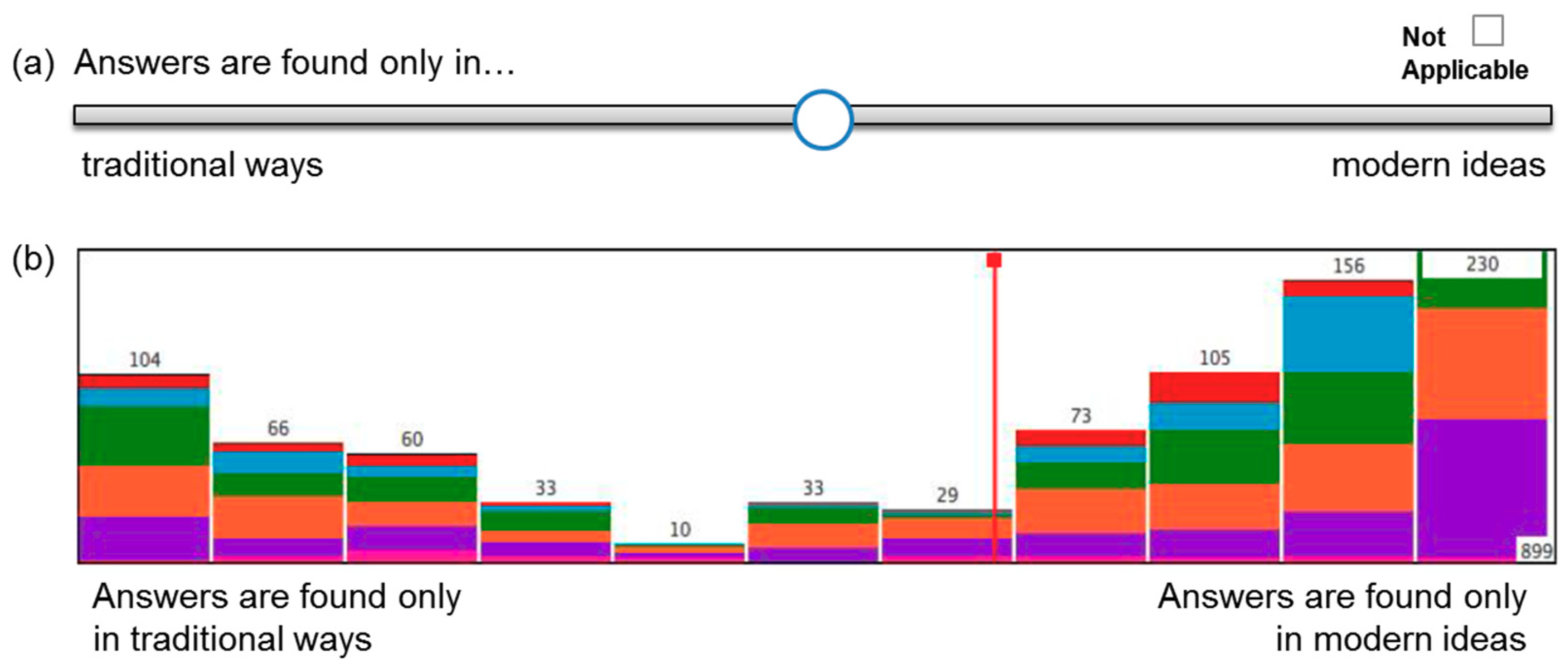

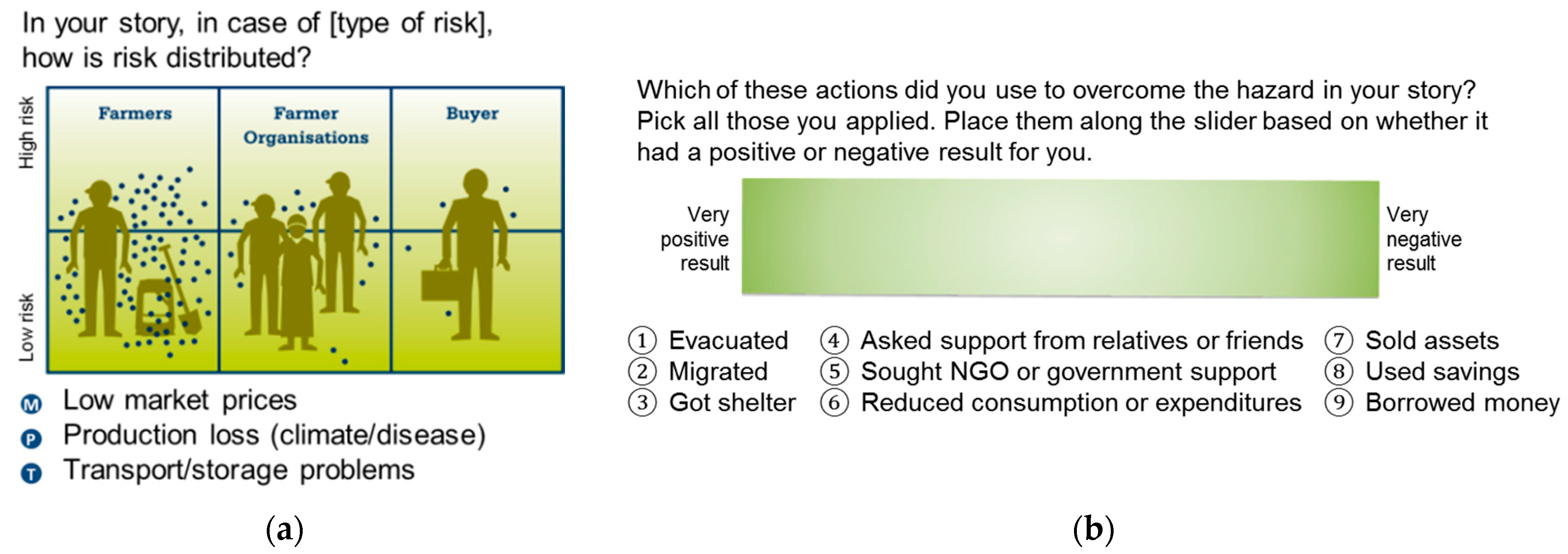
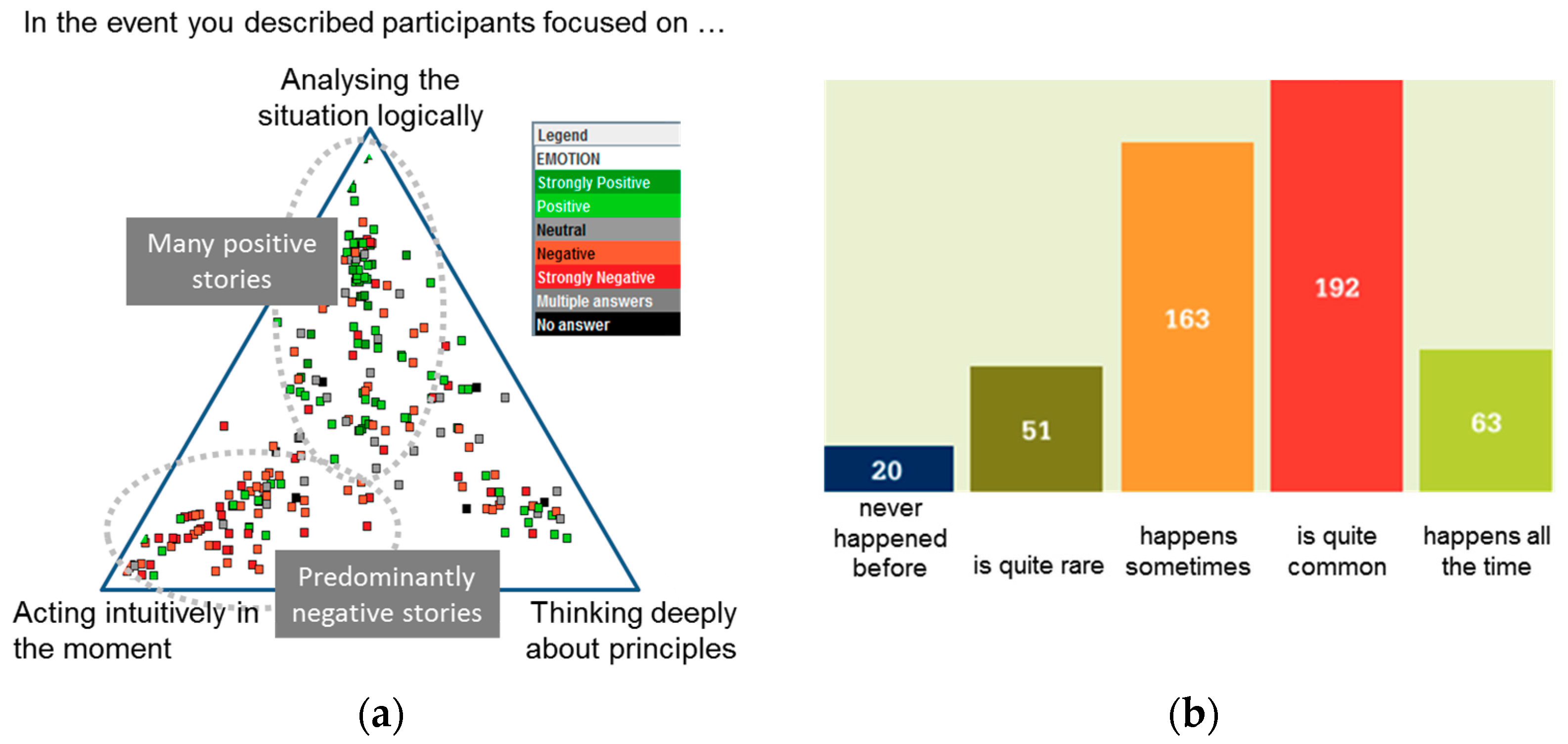
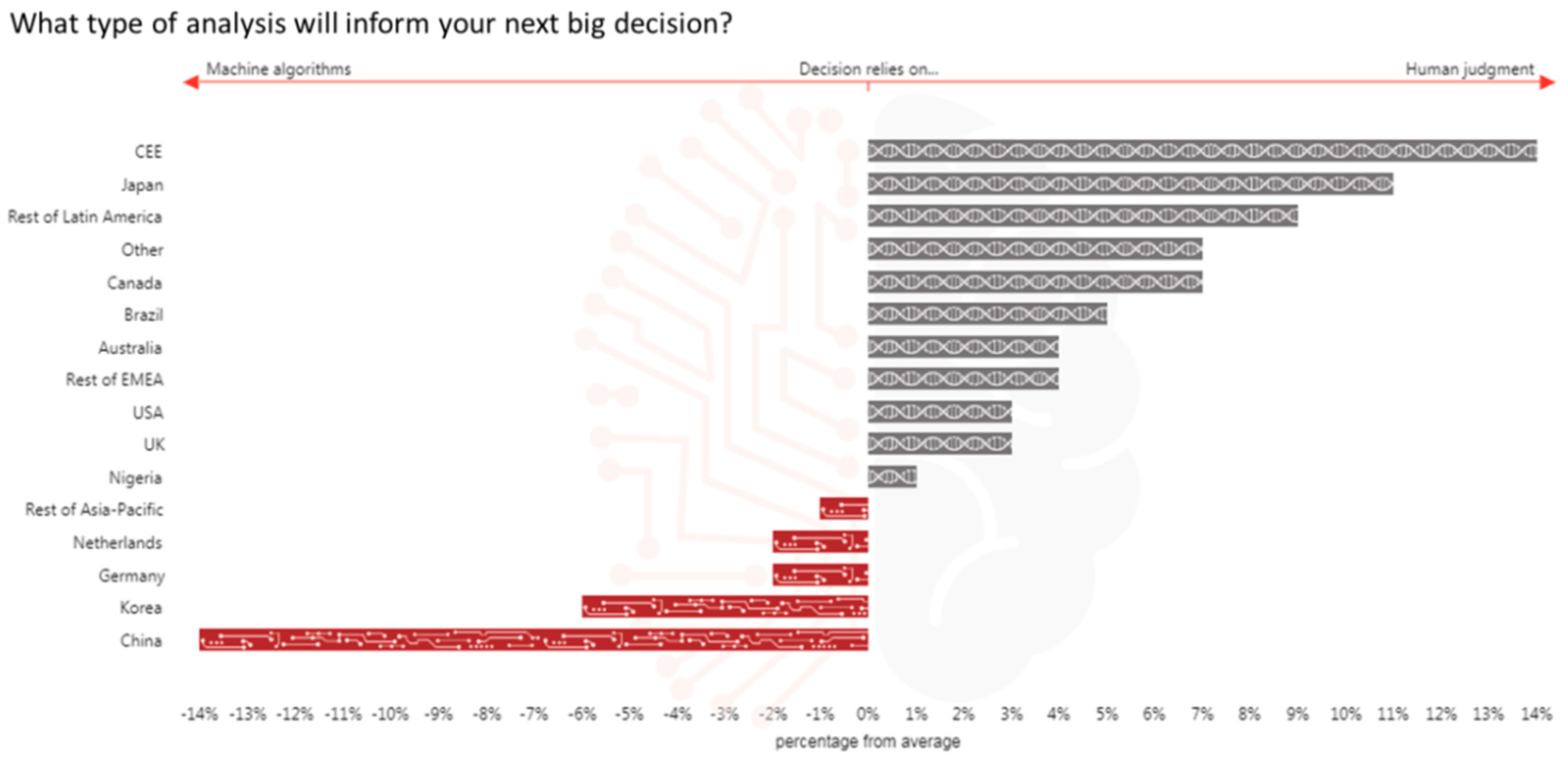
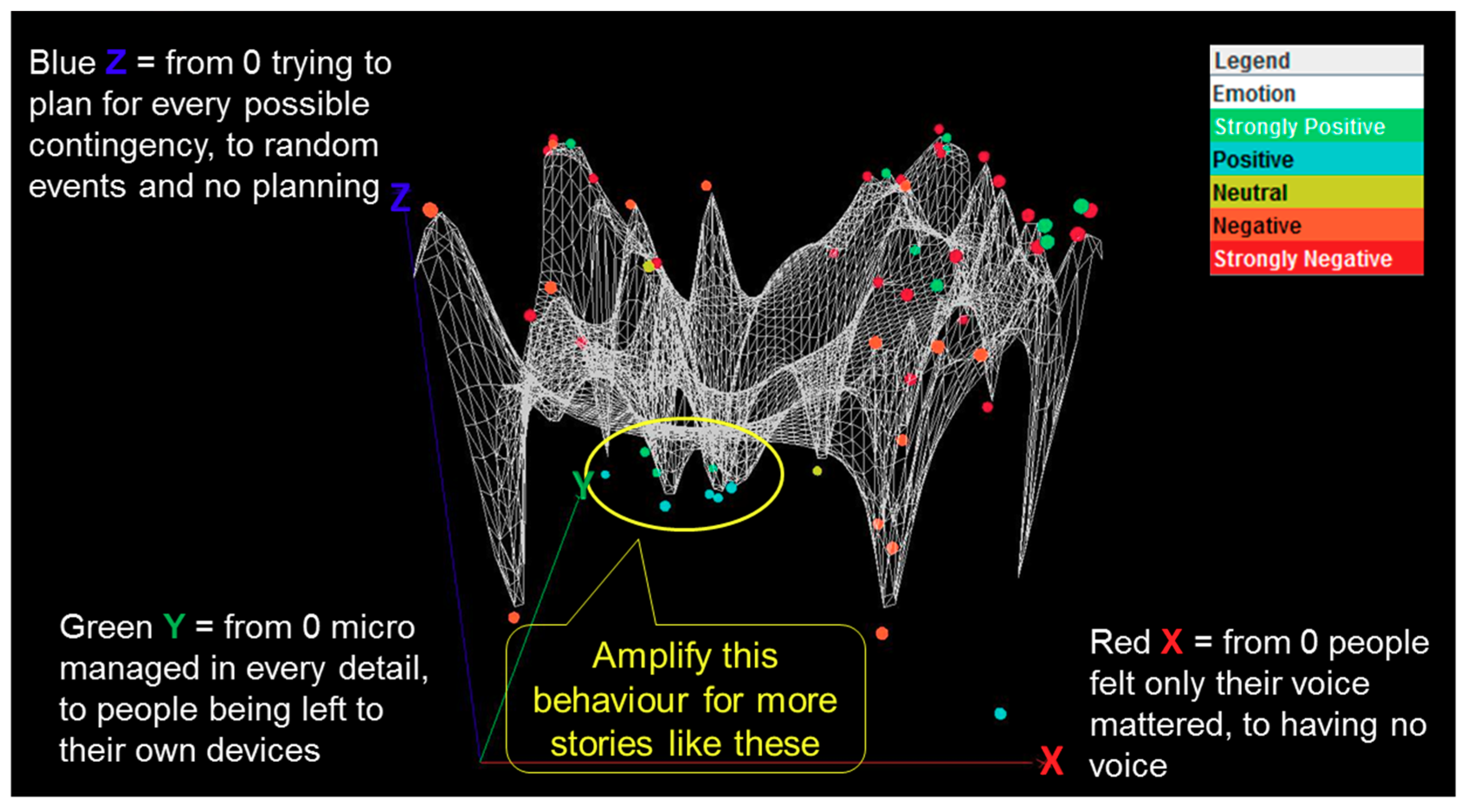
| Applications | Published Literature | Institutional Reports |
|---|---|---|
| Monitoring, evaluation & measuring impact | [64] | [55,56,59,65,66,67,68,69,70] |
| Mapping of ideation cultures, mind-sets & attitudes | [44,60,71,72,73,74,75,76,77,78] | [61,66,79,80,81,82,83] |
| Detecting trends | [84,85,86,87,88] | [89,90] |
| Purpose | Software | Description | Platform |
|---|---|---|---|
| Design | SenseMaker Designer | An online administrator interface that allows SenseMaker practitioners to create and customize new projects that can be used for narrative capture. Once the administrator publishes the project it becomes available through the use of a unique code to capture narratives. | Web front-end to an online configuration and data management service. |
| Collect | SenseMaker Collector app | To be used by participants or data collectors for collecting narratives and the signification of those narratives. Alternatively capture data directly from a website through any web browser. | Website through any browser, or App that run on Apple or Android smart devices. |
| View | SenseMaker Explore app | Project code access available on request, to monitor the number of narratives captured, see high level patterns among the narratives, and read individual narratives—not recommended practice. | App only available on Apple iPad. |
| Analysis | SenseMaker Analyst | A web-based analysis tool, currently less powerful than Explorer and Modeler, but with a more intuitive user interface and new functionality like x-y-plots. | Web interface to an online analysis tool. |
| SenseMaker Explorer and SenseMaker Modeler | An application that runs off a computer and access data locally that was extracted from the online-database. An analytical platform for finding statistical correlations, to slice and dice data; build 3D landscapes; compare patterns among sub groups and more. Has largely been replaced by the online SenseMaker Analyst. | Software installed on an Intel based platform, requires a Java plug-in. |
© 2019 by the authors. Licensee MDPI, Basel, Switzerland. This article is an open access article distributed under the terms and conditions of the Creative Commons Attribution (CC BY) license (http://creativecommons.org/licenses/by/4.0/).
Share and Cite
Van der Merwe, S.E.; Biggs, R.; Preiser, R.; Cunningham, C.; Snowden, D.J.; O’Brien, K.; Jenal, M.; Vosloo, M.; Blignaut, S.; Goh, Z. Making Sense of Complexity: Using SenseMaker as a Research Tool. Systems 2019, 7, 25. https://doi.org/10.3390/systems7020025
Van der Merwe SE, Biggs R, Preiser R, Cunningham C, Snowden DJ, O’Brien K, Jenal M, Vosloo M, Blignaut S, Goh Z. Making Sense of Complexity: Using SenseMaker as a Research Tool. Systems. 2019; 7(2):25. https://doi.org/10.3390/systems7020025
Chicago/Turabian StyleVan der Merwe, Susara E., Reinette Biggs, Rika Preiser, Charmaine Cunningham, David J. Snowden, Karen O’Brien, Marcus Jenal, Marietjie Vosloo, Sonja Blignaut, and Zhen Goh. 2019. "Making Sense of Complexity: Using SenseMaker as a Research Tool" Systems 7, no. 2: 25. https://doi.org/10.3390/systems7020025
APA StyleVan der Merwe, S. E., Biggs, R., Preiser, R., Cunningham, C., Snowden, D. J., O’Brien, K., Jenal, M., Vosloo, M., Blignaut, S., & Goh, Z. (2019). Making Sense of Complexity: Using SenseMaker as a Research Tool. Systems, 7(2), 25. https://doi.org/10.3390/systems7020025






